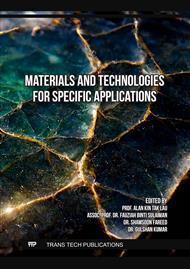[1]
B. Kang, G. Ceder, Battery materials for ultrafast charging and discharging. Nature. (2009) 190-193.
DOI: 10.1038/nature07853
Google Scholar
[2]
M. Li, J. Lu, Z. Chen, K. Amine, 30 years of lithium‐ion batteries. Adv. Mater. 30 (2018) 1800561.
Google Scholar
[3]
B. Scrosati, J. Hassoun, Y.-K. Sun, Lithium-ion batteries. A look into the future. Energ. Environ. Sci. 4 (2011) 3287-3295.
DOI: 10.1039/c1ee01388b
Google Scholar
[4]
J. Ji, H. Ji, L. L. Zhang, X. Zhao, Graphene‐encapsulated Si on ultrathin‐graphite foam as anode for high capacity lithium‐ion batteries. Adv. Mater. 25 (2013) 4673-4677.
DOI: 10.1002/adma.201301530
Google Scholar
[5]
M. Ge, C. Cao, G. M. Biesold, Recent advances in silicon‐based electrodes: from fundamental research toward practical applications. Adv. Mater. 33 (2021), 2004577.
DOI: 10.1002/adma.202170124
Google Scholar
[6]
L. Sun, Y. Liu, R. Shao, J. Wu, R. Jiang, Z. Jin, Recent progress and future perspective on practical silicon anode-based lithium ion batteries. Energ. Storage Mater., 46 (2022) 482-502.
DOI: 10.1016/j.ensm.2022.01.042
Google Scholar
[7]
J. R. Szczech, S. Jin, Nanostructured silicon for high capacity lithium battery anodes. Energ. Environ. Sci. 4 (2011) 56-72.
DOI: 10.1039/c0ee00281j
Google Scholar
[8]
X. Zhang, D. Wang, X. Qiu, Y. Ma, D. Kong, K. Müllen, X. Li, L. Zhi, Stable high-capacity and high-rate silicon-based lithium battery anodes upon two-dimensional covalent encapsulation. Nat. commun. 11 (2020) 3826.
DOI: 10.1038/s41467-020-17686-4
Google Scholar
[9]
J. Ma, J. Sung, Y. Lee, Y. Son, S. Chae, N. Kim, S. H. Choi, J. Cho, Strategic pore architecture for accommodating volume change from high Si content in lithium‐ion battery anodes. Adv. Energy Mater. 10 (2020) 1903400.
DOI: 10.1002/aenm.201903400
Google Scholar
[10]
L. Zhang, C. Wang, Y. Dou, N. Cheng, D. Cui, Y. Du, P. Liu, A yolk–shell structured silicon anode with superior conductivity and high tap density for full lithium‐ion batteries. Angew. Chem. Int. Edit. 58 (2019) 8824-8828.
DOI: 10.1002/anie.201903709
Google Scholar
[11]
W. Weng, J. Yang, J. Zhou, D. Gu, W. Xiao, Template‐Free Electrochemical Formation of Silicon Nanotubes from Silica. Adv. Sci. 7 (2020) 2001492.
DOI: 10.1002/advs.202001492
Google Scholar
[12]
Q. Ai, Q. Fang, J. Liang, X. Xu, T. Zhai, G. Gao, H. Guo, G. Han, L. Ci, J. Lou, Lithium-conducting covalent-organic-frameworks as artificial solid-electrolyte-interphase on silicon anode for high performance lithium ion batteries. Nano Energy. 72 (2020) 104657.
DOI: 10.1016/j.nanoen.2020.104657
Google Scholar
[13]
Z. Luo, Q. Xiao, G. Lei, Z. Li, C. Tang, Si nanoparticles/graphene composite membrane for high performance silicon anode in lithium ion batteries. Carbon. 98 (2016) 373-380.
DOI: 10.1016/j.carbon.2015.11.031
Google Scholar
[14]
X. Li, Y. Tang, J. Song, W. Yang, M. Wang, C. Zhu, W. Zhao, J. Zheng, Y. Lin, Self-supporting activated carbon/carbon nanotube/reduced graphene oxide flexible electrode for high performance supercapacitor. Carbon. 129 (2018) 236-244.
DOI: 10.1016/j.carbon.2017.11.099
Google Scholar
[15]
P. Wu, C. Guo, J. Han, K. Yu, X. Dong, G. Yue, H. Liu, A. Fabrication of double core–shell Si-based anode materials with nanostructure for lithium-ion battery. RSC adv. 8 (2018) 9094-9102.
DOI: 10.1039/c7ra13606d
Google Scholar
[16]
Y. Chen, Y. Hu, Z. Shen, R. Chen, X. He, X. Zhang, Y. Li, K. Wu, Hollow core–shell structured silicon@ carbon nanoparticles embed in carbon nanofibers as binder-free anodes for lithium-ion batteries. J. Power Sources. 342 (2017) 467-475.
DOI: 10.1016/j.jpowsour.2016.12.089
Google Scholar
[17]
A. Abnavi, M. S. Faramarzi, A. Abdollahi, R. Ramzani, S. Ghasemi, Z. Sanaee, SnO2@ a-Si core–shell nanowires on free-standing CNT paper as a thin and flexible Li-ion battery anode with high areal capacity. Nanotechnology. 28 (2017) 255404.
DOI: 10.1088/1361-6528/aa715b
Google Scholar
[18]
Y. Li, K. Yan, H. W. Lee, Z. Lu, N. Liu, Y. Cui, Growth of conformal graphene cages on micrometre-sized silicon particles as stable battery anodes. Nat. Energy. 1 (2016) 1-9.
DOI: 10.1038/nenergy.2015.29
Google Scholar
[19]
F. S. Li, Y. S. Wu, J. Chou, N. L.Wu, A dimensionally stable and fast-discharging graphite–silicon composite Li-ion battery anode enabled by electrostatically self-assembled multifunctional polymer-blend coating. Chem. Commun. 51 (2015) 8429-8431.
DOI: 10.1039/c4cc09825k
Google Scholar
[20]
S. Y. Kim, J. Lee, B.H. Kim, Y. J. Kim, K. S. Yang, M. S. Park, Facile synthesis of carbon-coated silicon/graphite spherical composites for high-performance lithium-ion batteries. ACS. Appl. Mater. 8 (2016) 12109-12117.
DOI: 10.1021/acsami.5b11628
Google Scholar
[21]
M. Ko, S. Chae, J. Ma, N. Kim, H. W. Lee, Y. Cui, J. Cho, Scalable synthesis of silicon-nanolayer-embedded graphite for high-energy lithium-ion batteries. Nat. Energy. 1 (2016), 1-8.
DOI: 10.1038/nenergy.2016.113
Google Scholar
[22]
M. Su, Z. Wang, H. Guo, X. Li, S. Huang, W. Xiao, L. Gan, Enhancement of the Cyclability of a Si/Graphite@ Graphene composite as anode for Lithium-ion batteries. Electrochim. Acta. 116, (2014) 230-236.
DOI: 10.1016/j.electacta.2013.10.195
Google Scholar
[23]
H. Wu, Y. Cui, Designing nanostructured Si anodes for high energy lithium ion batteries. Nano today. 7 (2012) 414-429.
DOI: 10.1016/j.nantod.2012.08.004
Google Scholar
[24]
K. Amezawa, N. Yamamoto, Y. Tomii, Y. Ito, Single‐electrode peltier heats of Li‐Si alloy electrodes in LiCl‐KCl eutectic melt. J. Electrochem. Soc. 145 (1998) 1986.
DOI: 10.1149/1.1838587
Google Scholar


